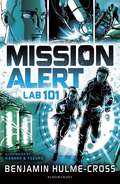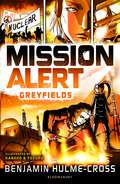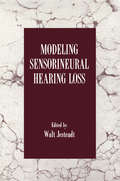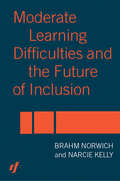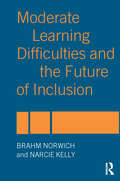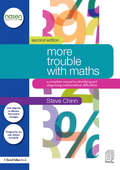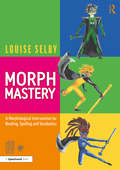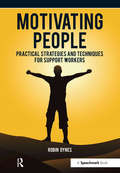- Table View
- List View
Mission Alert: Lab 101 (High/Low)
by Benjamin Hulme-CrossWhen the only way to get at a target is by using a child, MI5 bring in special agents Tom and Zilla to help. On a school trip to a robotics lab, Tom and Zilla need to figure out how to stop an army of robots being hired out to criminal gangs. Join them as they investigate the secrets of Lab 101.Bloomsbury High Low books encourage and support reading practice by providing gripping, age-appropriate stories for struggling and reluctant readers, those with dyslexia, or those with English as an additional language. Printed on tinted paper and with a dyslexia friendly font, Mission Alert is aimed at readers aged 8+ and has a manageable length (72 pages) and reading age (7+). This collection of stories can be read in any order.Produced in association with reading experts at CatchUp, a charity which aims to address underachievement caused by literacy and numeracy difficulties.Book band: Brown
Mission Alert: Greyfields (High/Low)
by Benjamin Hulme-CrossWhen the only way to get at a target is by using a child, MI5 bring in special agents Tom and Zilla to help. Something is going on at Greyfields nuclear power plant and Tom and Zilla need to find out what. Can they sneak into a camp of anti-nuclear protesters and foil the plans of a Russian spy? Bloomsbury High Low books encourage and support reading practice by providing gripping, age-appropriate stories for struggling and reluctant readers, those with dyslexia, or those with English as an additional language. Printed on tinted paper and with a dyslexia friendly font, Mission Alert is aimed at readers aged 8+ and has a manageable length (72 pages) and reading age (7+). This collection of stories can be read in any order.Produced in association with reading experts at CatchUp, a charity which aims to address underachievement caused by literacy and numeracy difficulties.Book band: Brown
Mission Alert: Mission Alert (High/Low)
by Mr Benjamin Hulme-CrossWhen the only way to get at a target is by using a child, MI5 bring in special agents Tom and Zilla to help. On a school trip to a robotics lab, Tom and Zilla need to figure out how to stop an army of robots being hired out to criminal gangs. Join them as they investigate the secrets of Lab 101.Bloomsbury High Low books encourage and support reading practice by providing gripping, age-appropriate stories for struggling and reluctant readers, those with dyslexia, or those with English as an additional language. Printed on tinted paper and with a dyslexia friendly font, Mission Alert is aimed at readers aged 8+ and has a manageable length (72 pages) and reading age (7+). This collection of stories can be read in any order.Produced in association with reading experts at CatchUp, a charity which aims to address underachievement caused by literacy and numeracy difficulties.Book band: Brown
Mission Alert: Mission Alert (High/Low)
by Mr Benjamin Hulme-CrossWhen the only way to get at a target is by using a child, MI5 bring in special agents Tom and Zilla to help. Something is going on at Greyfields nuclear power plant and Tom and Zilla need to find out what. Can they sneak into a camp of anti-nuclear protesters and foil the plans of a Russian spy? Bloomsbury High Low books encourage and support reading practice by providing gripping, age-appropriate stories for struggling and reluctant readers, those with dyslexia, or those with English as an additional language. Printed on tinted paper and with a dyslexia friendly font, Mission Alert is aimed at readers aged 8+ and has a manageable length (72 pages) and reading age (7+). This collection of stories can be read in any order.Produced in association with reading experts at CatchUp, a charity which aims to address underachievement caused by literacy and numeracy difficulties.Book band: Brown
Mission Dyslexia: Find Your Superpower and Be Your Brilliant Self
by Julie McNeill Paul McNeill Rossie StoneMeet Creatia, Persisto and Willforce. They are strong, determined and creative, and they represent the strengths that dyslexia can bring to your life. Together they encourage you to use your skills and talents to be confident in what you do - and shrink the villain Mr Dyspicibilia! This is a fun and interactive resource for grown-ups and children to work through together, with drawing and writing activities and examples to open up helpful discussions and find practical solutions that put the dyslexic child's self-esteem and self-understanding at the fore. The strategies in the book are brought to life through the three superheroes who help you develop a child's unique strengths to tackle the everyday challenges they may experience with reading, writing, staying organised or keeping track of the time. The colourful illustrations, cartoons and dialogue encourage children to name their feelings, identify challenges and recognise their own strengths in any situation.
Modeling Sensorineural Hearing Loss
by Walt JesteadtA recent study indicates that 20 million people in the United States have significant sensorineural hearing loss. Approximately 95% of those people have partial losses, with varying degrees of residual hearing. These percentages are similar in other developed countries. What changes in the function of the cochlea or inner ear cause such losses? What does the world sound like to the 19 million people with residual hearing? How should we transform sounds to correct for the hearing loss and maximize restoration of normal hearing? Answers to such questions require detailed models of the way that sounds are processed by the nervous system, both for listeners with normal hearing and for those with sensorineural hearing loss. This book contains chapters describing the work of 25 different research groups. A great deal of research in recent years has been aimed at obtaining a better physiological description of the altered processes that cause sensorineural hearing loss and a better understanding of transformations that occur in the perception of those sounds that are sufficiently intense that they can still be heard. Efforts to understand these changes in function have lead to a better understanding of normal function as well. This research has been based on rigorous mathematical models, computer simulations of mechanical and physiological processes, and signal processing simulations of the altered perceptual experience of listeners with sensorineural hearing loss. This book provides examples of all these approaches to modeling sensorineural hearing loss and a summary of the latest research in the field.
Modeling Sensorineural Hearing Loss
by Walt JesteadtA recent study indicates that 20 million people in the United States have significant sensorineural hearing loss. Approximately 95% of those people have partial losses, with varying degrees of residual hearing. These percentages are similar in other developed countries. What changes in the function of the cochlea or inner ear cause such losses? What does the world sound like to the 19 million people with residual hearing? How should we transform sounds to correct for the hearing loss and maximize restoration of normal hearing? Answers to such questions require detailed models of the way that sounds are processed by the nervous system, both for listeners with normal hearing and for those with sensorineural hearing loss. This book contains chapters describing the work of 25 different research groups. A great deal of research in recent years has been aimed at obtaining a better physiological description of the altered processes that cause sensorineural hearing loss and a better understanding of transformations that occur in the perception of those sounds that are sufficiently intense that they can still be heard. Efforts to understand these changes in function have lead to a better understanding of normal function as well. This research has been based on rigorous mathematical models, computer simulations of mechanical and physiological processes, and signal processing simulations of the altered perceptual experience of listeners with sensorineural hearing loss. This book provides examples of all these approaches to modeling sensorineural hearing loss and a summary of the latest research in the field.
Models For Mainstreaming For Visually Impaired Pupils (PDF): Studies of Current Practice With Guidelines for Service Development
by Jasmine Dawkins Royal National Institute for the Blind StaffThe desirability of integrating visually impaired children into the mainstream is now widely accepted. However, the quality of education which such children receive depends, to a certain extent, on where they happen to live.;This book is the outcome of a study, commissioned by the RNIB, of visual impairment services in various parts of the country and their impact on the children for whom they are designed. Written to inform and assist those who are concerned in educating visually impaired children, and who are currently reviewing or developing services, it contains a compendium of reference material on which they may draw to inform committee members in their decision making.;Section I analyzes the nature of provision which is currently made for visually impaired pupils in eight LEAs. Section II provides individual studies of 14 children with different types of visual impairment. Section III draws together the facts collected relating to various aspects of service provision and offers a commentary on their strengths and weaknesses. Section IV sets out guidelines for those who are providing for the needs of visually impaired children and covers a wide range to cater for the diverse circumstances in which the provision is made.
Moderate Learning Difficulties and the Future of Inclusion
by Narcie Kelly Brahm NorwichChildren with mild to moderate learning difficulties (MLD) make up the largest sub-group of children requiring special educational needs, and yet they are often neglected in terms of research and in their influence on future Government policies. This book, based on a Nuffield Foundation research project, considers the perspectives of children with moderate learning difficulties, reviewing relevant issues such as:* identification of children with MLD;* appropriate curriculum and pedagogy;* inclusion in mainstream schools; * their identity and self-perception.The authors weave their findings into a wider review of current research in the MLD field and use a range of perspectives, from the professional, to psychological and sociological.This is a contemporary look at MLD that discusses the historical and policy context , origins and justification for having a category for MLD. Students, researchers, and academics that are active in the field of inclusive education will find this an insightful and comprehensive text.
Moderate Learning Difficulties and the Future of Inclusion
by Narcie Kelly Brahm NorwichChildren with mild to moderate learning difficulties (MLD) make up the largest sub-group of children requiring special educational needs, and yet they are often neglected in terms of research and in their influence on future Government policies. This book, based on a Nuffield Foundation research project, considers the perspectives of children with moderate learning difficulties, reviewing relevant issues such as:* identification of children with MLD;* appropriate curriculum and pedagogy;* inclusion in mainstream schools; * their identity and self-perception.The authors weave their findings into a wider review of current research in the MLD field and use a range of perspectives, from the professional, to psychological and sociological.This is a contemporary look at MLD that discusses the historical and policy context , origins and justification for having a category for MLD. Students, researchers, and academics that are active in the field of inclusive education will find this an insightful and comprehensive text.
Monica Plum's Horrid Problem (Helping Children with Feelings)
by Margot Sunderland Nicky ArmstrongThis is a story for children with troubled parents. Monica has a horrid problem. It gets everywhere: into her schoolwork, her dreams, and her ability to make friends. People keep telling her to cheer up. She can't. She feels as if she is carrying around some very heavy luggage. Then one day, a helpful teacher sees how miserable Monica is, and tells her about the knights in the world, who are posing as people. In a whispering wood, Monica finds some of these knights. They teach her how to make her problem far less horrid. In particular they show her how to cope when other people's problems weigh you down and make you feel miserable. Most importantly they show her how to do life well. Monica leaves whispering wood feeling empowered and ready to face what she could not face before.
Monica Plum's Horrid Problem: A Story For Children Of Troubled Parents (Helping Children with Feelings)
by Margot Sunderland Nicky ArmstrongThis is a story for children with troubled parents. Monica has a horrid problem. It gets everywhere: into her schoolwork, her dreams, and her ability to make friends. People keep telling her to cheer up. She can't. She feels as if she is carrying around some very heavy luggage. Then one day, a helpful teacher sees how miserable Monica is, and tells her about the knights in the world, who are posing as people. In a whispering wood, Monica finds some of these knights. They teach her how to make her problem far less horrid. In particular they show her how to cope when other people's problems weigh you down and make you feel miserable. Most importantly they show her how to do life well. Monica leaves whispering wood feeling empowered and ready to face what she could not face before.
Monstrous Kinds: Body, Space, and Narrative in Renaissance Representations of Disability (Corporealities: Discourses Of Disability)
by Elizabeth BeardenMonstrous Kinds is the first book to explore textual representations of disability in the global Renaissance. Elizabeth B. Bearden contends that monstrosity, as a precursor to modern concepts of disability, has much to teach about our tendency to inscribe disability with meaning. Understanding how early modern writers approached disability not only provides more accurate genealogies of disability, but also helps nuance current aesthetic and theoretical disability formulations. The book analyzes the cultural valences of early modern disability across a broad national and chronological span, attending to the specific bodily, spatial, and aesthetic systems that contributed to early modern literary representations of disability. The cross section of texts (including conduct books and treatises, travel writing and wonder books) is comparative, putting canonical European authors such as Castiglione into dialogue with transatlantic and Anglo-Ottoman literary exchange. Bearden questions grand narratives that convey a progression of disability from supernatural marvel to medical specimen, suggesting that, instead, these categories coexist and intersect.
More Creative Coping Skills for Children: Activities, Games, Stories, and Handouts to Help Children Self-regulate (PDF)
by Bonnie ThomasThis collection of fun and adaptable activities, games, stories and handouts is a complete resource for supporting children coping with stress and difficult emotions. From engaging arts and crafts, to interactive stories and relaxing meditations, all the interventions and activities are thematically structured so that each chapter contains the means for building specific skills or overcoming behavioral issues. Each chapter contains suggested goals, positive affirmations and photocopiable handouts to enable a child to continue practising and learning new life skills outside of sessions with parents or professionals. The activities in this book are ideal for use with children aged 3-12 to help them rebalance and gain a strong grasp on their emotions.
More Fun Games and Activities for Children with Dyslexia: How to Learn Smarter with a Dyslexic Brain (Fun Games and Activities for Children with Dyslexia)
by Alais WintonDyslexic teacher Alais Winton is back with all-new games and activities to make learning simple and fun.This inventive and practical workbook is packed with tried-and-tested games and activities to help children aged 7-13 who have dyslexia. It is ideally suited to home-schooling, independent learning, or classroom or small group setting, and includes activities such as The Multiply Matrix Game, Drop the Ball and Number Tag.The book is packed with cartoons, and there's a quiz at the start to help you discover whether you learn best from pictures, movement, socially or through music. You can use this book to find the strategies and activities you enjoy the most, and that support you to learn most effectively. If you have ideas about how you would like to add to the games or invent your own, go for it!With even more engaging activities and updated advice for parents and carers, this is another essential tool for making learning simple and enjoyable.
More Than Medals: A History of the Paralympics and Disability Sports in Postwar Japan
by Dennis J. FrostHow does a small provincial city in southern Japan become the site of a world-famous wheelchair marathon that has been attracting the best international athletes since 1981?In More Than Medals, Dennis J. Frost answers this question and addresses the histories of individuals, institutions, and events—the 1964 Paralympics, the FESPIC Games, the Ōita International Wheelchair Marathon, the Nagano Winter Paralympics, and the 2021 Tokyo Summer Games that played important roles in the development of disability sports in Japan. Sporting events in the postwar era, Frost shows, have repeatedly served as forums for addressing the concerns of individuals with disabilities. More Than Medals provides new insights on the cultural and historical nature of disability and demonstrates how sporting events have challenged some stigmas associated with disability, while reinforcing or generating others.Frost analyzes institutional materials and uses close readings of media, biographical sources, and interviews with Japanese athletes to highlight the profound—though often ambiguous—ways in which sports have shaped how postwar Japan has perceived and addressed disability. His novel approach highlights the importance of the Paralympics and the impact that disability sports have had on Japanese society.
More Trouble with Maths: A Complete Manual to Identifying and Diagnosing Mathematical Difficulties (nasen spotlight)
by Steve ChinnMore Trouble with Maths acknowledges that there are many reasons why children and adults are unable to function mathematically. Difficulties include problems with rote learning basic facts and procedures, debilitating anxiety, poor working and short-term memories and mathematics vocabulary. Central to this new edition is a range of standardised tests and diagnostic activities, including a 15 minute test of basic mathematics, a thinking style test, tests of basic fact retrieval and maths anxiety. Guiding the reader in the interpretation of tests, this new edition shows how identifying the barriers to learning is the first step in a programme of intervention. Written in an engaging and user-friendly style, Steve Chinn draws on his extensive experience and expertise to: show how to consider and appraise the many factors relating to mathematical learning difficulties explain how these factors can be investigated explore their impact on learning mathematics. Emphasising the need for a clinical approach when assessing individuals, this book shows how diagnosis and assessment can become integrated into everyday teaching. This highly practical and relevant resource is a crucial resource for anyone who wants to accurately and effectively identify the depth and nature of mathematical learning difficulties and dyscalculia.
More Trouble with Maths: A Complete Manual to Identifying and Diagnosing Mathematical Difficulties (nasen spotlight)
by Steve ChinnMore Trouble with Maths acknowledges that there are many reasons why children and adults are unable to function mathematically. Difficulties include problems with rote learning basic facts and procedures, debilitating anxiety, poor working and short-term memories and mathematics vocabulary. Central to this new edition is a range of standardised tests and diagnostic activities, including a 15 minute test of basic mathematics, a thinking style test, tests of basic fact retrieval and maths anxiety. Guiding the reader in the interpretation of tests, this new edition shows how identifying the barriers to learning is the first step in a programme of intervention. Written in an engaging and user-friendly style, Steve Chinn draws on his extensive experience and expertise to: show how to consider and appraise the many factors relating to mathematical learning difficulties explain how these factors can be investigated explore their impact on learning mathematics. Emphasising the need for a clinical approach when assessing individuals, this book shows how diagnosis and assessment can become integrated into everyday teaching. This highly practical and relevant resource is a crucial resource for anyone who wants to accurately and effectively identify the depth and nature of mathematical learning difficulties and dyscalculia.
More Trouble with Maths: A Complete Manual to Identifying and Diagnosing Mathematical Difficulties (David Fulton / Nasen Ser.)
by Steve ChinnNow in an updated third edition, this invaluable resource takes a practical and accessible approach to identifying and diagnosing many of the factors that contribute to mathematical learning difficulties and dyscalculia. Using a combination of formative and summative approaches, it provides a range of norm-referenced, standardised tests and diagnostic activities, each designed to reveal common error patterns and misconceptions in order to form a basis for intervention. Revised to reflect developments in the understanding of learning difficulties in mathematics, the book gives a diagnostic overview of a range of challenges to mathematical learning, including difficulties in grasping and retaining facts, problems with mathematics vocabulary and maths anxiety. Key features of this book include: Photocopiable tests and activities designed to be presented in a low-stress way Guidance on the interpretation of data, allowing diagnosis and assessment to become integrated into everyday teaching Sample reports, showing the diagnostic tests in practice Drawing on tried and tested methods, as well as the author’s extensive experience and expertise, this book is written in an engaging and user-friendly style. It is a vital resource for anyone who wants to accurately identify the depth and nature of mathematical learning difficulties and dyscalculia.
More Trouble with Maths: A Complete Manual to Identifying and Diagnosing Mathematical Difficulties (David Fulton / Nasen Ser.)
by Steve ChinnNow in an updated third edition, this invaluable resource takes a practical and accessible approach to identifying and diagnosing many of the factors that contribute to mathematical learning difficulties and dyscalculia. Using a combination of formative and summative approaches, it provides a range of norm-referenced, standardised tests and diagnostic activities, each designed to reveal common error patterns and misconceptions in order to form a basis for intervention. Revised to reflect developments in the understanding of learning difficulties in mathematics, the book gives a diagnostic overview of a range of challenges to mathematical learning, including difficulties in grasping and retaining facts, problems with mathematics vocabulary and maths anxiety. Key features of this book include: Photocopiable tests and activities designed to be presented in a low-stress way Guidance on the interpretation of data, allowing diagnosis and assessment to become integrated into everyday teaching Sample reports, showing the diagnostic tests in practice Drawing on tried and tested methods, as well as the author’s extensive experience and expertise, this book is written in an engaging and user-friendly style. It is a vital resource for anyone who wants to accurately identify the depth and nature of mathematical learning difficulties and dyscalculia.
Morph Mastery: A Morphological Intervention For Reading Spelling And Vocabulary
by Louise SelbyMorph Mastery is an accessible, practical guide designed to support learners with specific learning difficulties (SpLD) who are struggling with spelling, reading and vocabulary. It is an effective, research-based and fun solution for when phonics-based teaching has run its course. Understanding the morphological regularities in English helps to support both spelling and reading comprehension, yet there are few practical interventions that take a morphological approach. Morph Mastery combines this exciting new approach with tried-and-tested teaching methods that work. The activities in this book follow three engaging ninja-like characters, Prefa, Root and Sufa, who represent the three core components of morphology (prefixes, root words and suffixes) and use their sceptres to craft words. Key features include: • Exciting and engaging activities and games, designed to be used by individuals or small groups • Detailed, curriculum-linked assessments, enabling specific target setting • Photocopiable and downloadable activity sheets and resources Written in a user-friendly tone, for teaching assistants, teachers and other professionals with little or no specialist knowledge, this book is a must for any school with struggling readers and writers aged 9–13.
Morph Mastery: A Morphological Intervention for Reading, Spelling and Vocabulary
by Louise SelbyMorph Mastery is an accessible, practical guide designed to support learners with specific learning difficulties (SpLD) who are struggling with spelling, reading and vocabulary. It is an effective, research-based and fun solution for when phonics-based teaching has run its course. Understanding the morphological regularities in English helps to support both spelling and reading comprehension, yet there are few practical interventions that take a morphological approach. Morph Mastery combines this exciting new approach with tried-and-tested teaching methods that work. The activities in this book follow three engaging ninja-like characters, Prefa, Root and Sufa, who represent the three core components of morphology (prefixes, root words and suffixes) and use their sceptres to craft words. Key features include: • Exciting and engaging activities and games, designed to be used by individuals or small groups • Detailed, curriculum-linked assessments, enabling specific target setting • Photocopiable and downloadable activity sheets and resources Written in a user-friendly tone, for teaching assistants, teachers and other professionals with little or no specialist knowledge, this book is a must for any school with struggling readers and writers aged 9–13.
Mothering Special Needs: A Different Maternal Journey (PDF)
by Anna Kingston Christopher GillbergThis book explores the lived experience of mothers raising a child with a learning disability, through interviews with mothers of children with autistic spectrum disorder (ASD), attention deficit hyperactivity disorder (ADHD) and Down syndrome. With frequent personal accounts from mothers themselves, Mothering Special Needs encourages other women who have children with special needs to recognize and express their own aspirations and needs for self-fulfilment. It addresses the social construction of motherhood, discussing issues such as mother-blame and society's images of the self-sacrificing mother, in the context of raising a child with a learning disability. It also looks at real-life experiences of working with professionals, giving examples of both good and bad practice. This is an invaluable book for mothers as well as for professionals working with families that include children with disabilities.
Motivating People: Practical Strategies and Techniques for Support Workers
by Robin DynesIn all types of support services and care situations one of the biggest challenges is motivating people to change their behaviour. It particularly applies to individuals who are difficult to motivate because they might lack insight, wilfully ignore or refuse to face their situation, are affected by depression or health problems or are victims of unfortunate circumstances or fear of failure. The task may be to motivate someone to improve their quality of life by participating in a group in a residential home, change a lifestyle because of health reasons, address offending behaviour, learn a new skill to obtain a job or complete an anxiety management programme. The strategies and techniques will help: arouse their interest in making changes; encourage the consideration of change; support their planning for change; mentor the person through planned actions; ensure momentum is maintained; guide the person in making positive use of any relapses; and make sure the change is successfully achieved. This is an invaluable resource for support workers, social workers, health workers, youth workers, probation officers, employment services, tutors and carers. The techniques can be applied when working with individuals or groups in all types of settings including residential homes, day centres, probation, education or youth work.
Motivating People: Practical Strategies and Techniques for Support Workers
by Robin DynesIn all types of support services and care situations one of the biggest challenges is motivating people to change their behaviour. It particularly applies to individuals who are difficult to motivate because they might lack insight, wilfully ignore or refuse to face their situation, are affected by depression or health problems or are victims of unfortunate circumstances or fear of failure. The task may be to motivate someone to improve their quality of life by participating in a group in a residential home, change a lifestyle because of health reasons, address offending behaviour, learn a new skill to obtain a job or complete an anxiety management programme. The strategies and techniques will help: arouse their interest in making changes; encourage the consideration of change; support their planning for change; mentor the person through planned actions; ensure momentum is maintained; guide the person in making positive use of any relapses; and make sure the change is successfully achieved. This is an invaluable resource for support workers, social workers, health workers, youth workers, probation officers, employment services, tutors and carers. The techniques can be applied when working with individuals or groups in all types of settings including residential homes, day centres, probation, education or youth work.
